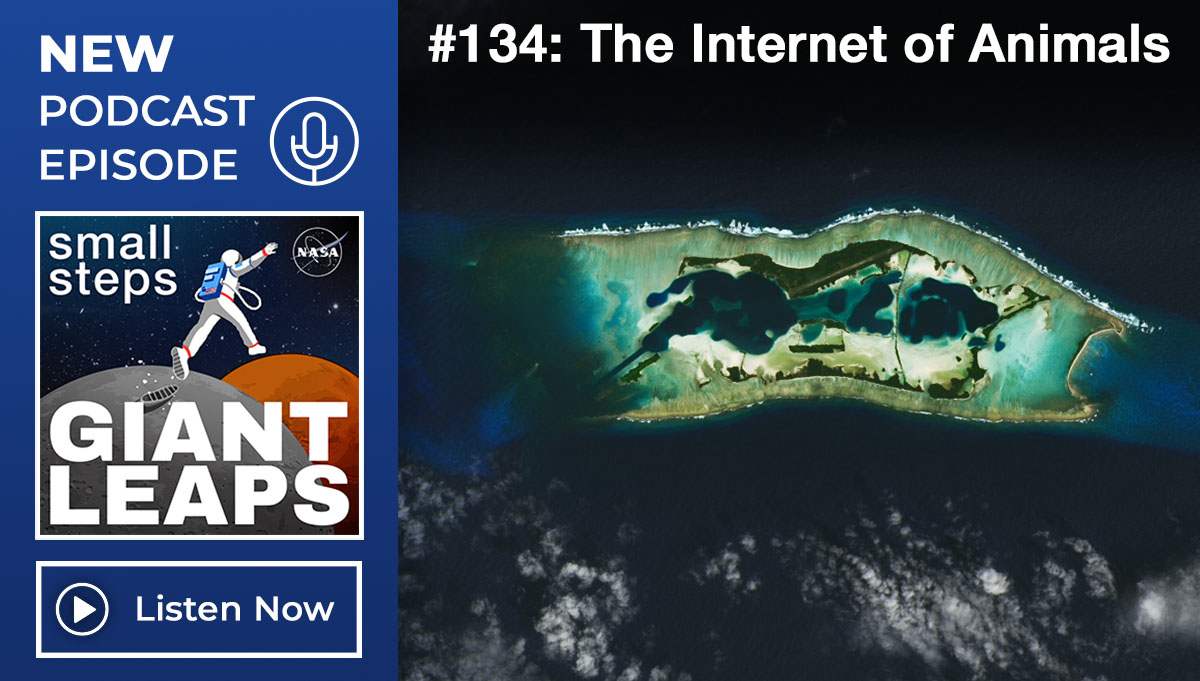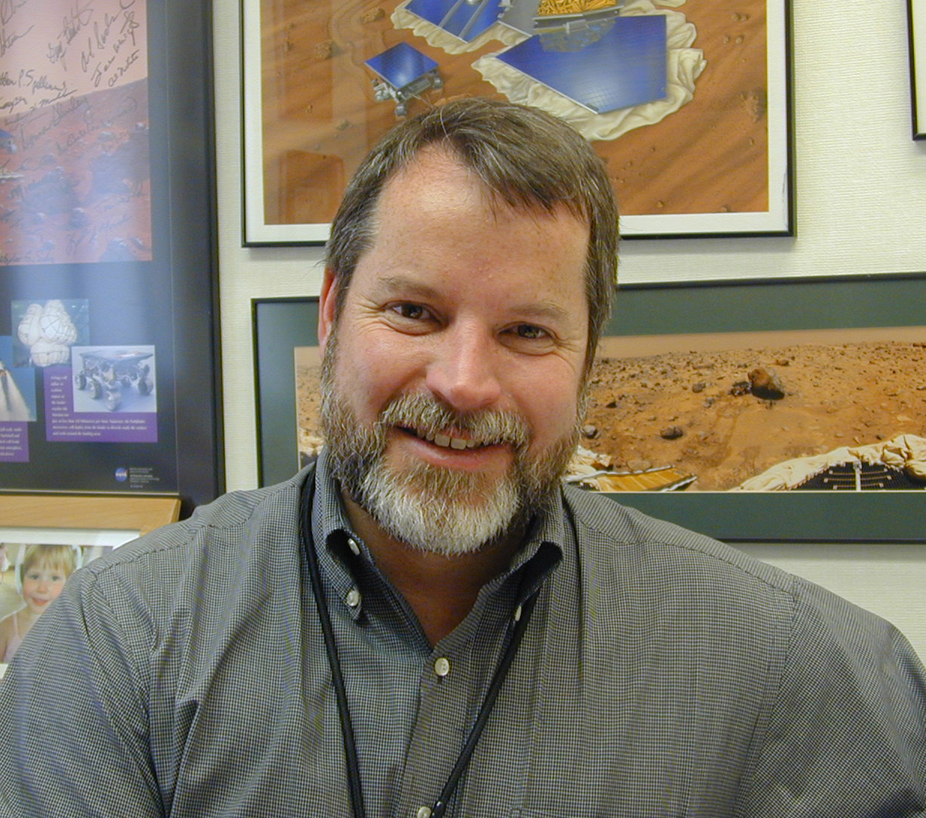
This artist's concept shows the MAVEN spacecraft in orbit around the Red Planet, with a fanciful image of her home planet in the background.
Image Credit: NASA / Goddard Space Flight Center
By Don Cohen
Lisa May is the program executive for MAVEN, the Mars Atmosphere and Volatile Evolution mission, in NASA’s Science Mission Directorate (SMD). In her spare time, she acts as the female voice of NASA’s ScienceCasts. Don Cohen spoke with her at NASA Headquarters.
Cohen: How long have you been involved with MAVEN?
May: I have been with MAVEN since before there was a MAVEN. I started working on the Mars Scout announcement of opportunity in the fall of 2006, right about the time we downselected to two proposals. MAVEN was selected in September 2008.
Cohen: How does the selection process work?
May: It’s a formal process that we take very seriously in the Science Mission Directorate. The first step is a broad call for scientific investigation. The principal-investigator-led proposals submitted are reviewed by external peer reviewers for science and for initial technical feasibility. We select the ones that rise to the top in that process to go on to a competitive Phase A, which is the very first step of mission formulation. Out of that, we get a funded concept-study report, which is a substantial document. The proposals have already been selected as having excellent science. We look at science feasibility: Will the instruments and operations proposed in this much more technical document actually support doing the excellent science that we want to select and fly? Step two also includes detailed evaluation of the budget and resources required as well as the management approach.
Cohen: Who makes the final decision?

May: In the case of MAVEN, that’s an interesting story. Our brand new SMD associate administrator at the time, Dr. Stern, had been the PI [principal investigator] on one of the two proposals selected. There was a lot of discussion with legal about what his role could be. What it came down to was that he could not be involved in anything that had to be approved about the concept-study reports, guidelines, and selection process. Chris Scolese, the agency associate administrator, became the selection official. When Dr. Stern left, Dr. Weiler came back. He had been center director at Goddard and had signed the concept-study report for MAVEN, which was proposed from Goddard. So he also had a conflict. For probably the first time, the Science Mission Directorate AA [associate administrator] could not be involved in the decision making. The NASA AA, Chris Scolese, made the selection.
Cohen: So there was an unusual amount of potential conflict of interest to work around.
May: There was a different issue of potential conflict of interest having to do with the initial concept-study report. We had to develop an entire new review panel, which took time. So we decided we would slip the mission launch from 2011 to 2013. Mars missions are difficult. They generally have an aggressive development schedule; PI-led missions are cost capped. Adding risk by cutting a good chunk out of their development schedule was just not acceptable. Interestingly, the universe decided to cooperate. The science goal of both missions in the competition was to understand the effects of solar events—winds, ions—on the Mars upper atmosphere. The last solar cycle actually dawdled along and the new solar cycle did not ramp up for almost two years, which is about the length of the delay. The fact that the solar cycle happened to be delayed by almost two years was a fortunate coincidence.
Cohen: What role do you play in MAVEN as program executive?
May: The way I frequently describe my job to people is this: When you have a moving vehicle, you’ve got an engine that drives things and you’ve got the rubber that meets the road. In the case of space missions, the engine is the administration and Congress. They give us direction and funding. The rubber meets the road at the universities and industry partners and NASA centers that build and deliver the hardware and do the science. In between, you need something to keep the gears from grinding. That’s the program executive.
Cohen: So what would be a typical situation where the gears threatened to grind?
May: One of the interesting facets of being an agency that builds and delivers things as part of a broader federal government is that oversight, reporting, and data requirements constantly shift as the government expands and contracts, as it looks inward and reports outward. People in various organizations and within NASA want to know more and more about how a project is doing. There is an endless search for tools that enable us to understand and predict how a mission is going to do and where you might need funding later. It’s good, responsible management to want to be able to more accurately predict where you want to apply your funding. But saying, “NASA has new tools for figuring out how to do that,” is a real hardship for the lean team of a cost-capped and schedule-constrained mission. One of the jobs I do on a semi-regular basis is push back and ask these organizations, “What are you going to do with this tool? How do you use this data? Can I give you the data? Is there existing data you can use?” I try to protect the MAVEN management team from things they had not been asked to plan for. And from requirements creep. I stand up for the project and find ways for the people who need information to get it without derailing some significant activity, and I try to maintain the integrity of what we selected on behalf of the taxpayers and the science investigation we signed up to get.
I stand up for the project and find ways for the people who need information to get it without derailing some significant activity, and I try to maintain the integrity of what we selected on behalf of the taxpayers and the science investigation we signed up to get.
Cohen: The requests for information come to you?
May: In general they do. I try to make sure that either I or the Mars Program Office can handle as many of them as possible. Sometimes organizations want to talk to the project without having a Headquarters filter. That’s understandable, though I have a very good relationship with the project and what they’ll hear from the project is what they’ll hear from me and what they’ll hear from the program office. We have a collaborative relationship and a really good flow of information back and forth.
Cohen: Do you regularly attend MAVEN project meetings?
May: There are regular meetings I attend. Despite our collegial relationship and the fact that I came from Goddard and have known many of these people for a long time, when Headquarters shows up in the room, it affects how a meeting goes. I absolutely understand that they need to do their work, so we pick and choose when and how I get my information. I have tag-ups with their management team weekly; there are quarterly meetings I attend. When they have their monthly meetings at Goddard, I sit down with them and talk about things in their monthly report and things we need for reviews coming up. They are a refreshingly transparent project, but I respect their need to get their work done without Headquarters in the room.
Cohen: So how are things going?
May: I’ve just had two very full days with the MAVEN team, and I’m feeling content with the way things are going. Maybe to an unusual degree, this project team raises problems immediately so everybody can say, “What can we do to help?” It’s a different kind of approach to the model that says, “Don’t ever take your boss a problem you don’t have a solution for.” That’s a standard supervisory relationship.
Cohen: But not a good strategy, I would say.
May: There may be advantages to it, but I’m finding it extremely satisfying to work on a project where people raise problems early. Most times, they are not problems I can solve or have to solve, but they are things I have to know about. My job is to make sure they’re being solved. The other part of my job is to report across the Planetary Science Division, because so many of our projects are related; they have a shared pedigree. The spacecraft buses of Mars Reconnaissance Orbiter, GRAIL, Juno, and MAVEN are all from the same family at Lockheed. So if MAVEN comes across something, its very important to have program execs [PEs] who can stand up in a program review and say to the other PEs, Hey, did you see this on your bus? And the instruments are very similar; several of the MAVEN instruments have flown on heliophysics missions. Being able to talk to the helio people and say, “We have a parts issue. How is your mission going?” is valuable. None of these problems are insurmountable, but they are things that you wouldn’t want someone else’s mission to trip up on in case they missed them. It’s really helpful to say, “This piece was slow to deliver on the last project; is your project planning around that?”
Cohen: So the communication goes in many directions.
May: There are formal reporting systems in NASA for problems, but having our own community here in the Science Mission Directorate helps. And the PEs help each other with process issues, too. As I’ve said, there is a lot of documentation, paperwork, things that have to be done at a particular point in the life cycle. We sit down with each other and say, How did you handle this particular requirement? Then you can go back to the project and say, This is a successful way for you to approach this or This other project that is a little further on in its development handled it this way and I think this is going to work for you. Lets get it sorted out now early so that it doesn’t plague you at your major reviews or other milestones.
Cohen: A lot of knowledge sharing.
May: We have a Mars Program Office at JPL [Jet Propulsion Laboratory], and my mission manager there is much more involved in day-to-day tag-ups with the project and project details than I am. His JPL expertise—those folks have done Mars mission after Mars mission—helps Goddard with their first Mars mission, helping them as needed to understand specific issues as they crop up.
Cohen: How long have you been at NASA?
May: In September, it will be twelve years—ten at Headquarters.
Being able to talk to the helio people and say, “We have a parts issue. How is your mission going?” is valuable.
Cohen: Do you have an engineering or science background?
May: I’m just old enough that people told me I should be a doctor because I was good at math and science. I’m just young enough that they didn’t tell me I should be a nurse. But no one said I should be an engineer. I had no idea what an engineer did. I went pre-med, and I hated it. I ended up majoring in communication and working in radio news. I was the only communications major taking calculus and physics and the design of programming languages. I was probably the only speech major who was working the card decks in the basement of Gilmore Hall at UVA [University of Virginia]. I gravitated toward engineering. I ended up being an English grader for the man who became my future advisor. He felt very strongly that engineers needed to know how to communicate. That’s how I met him and ended up moving on to engineering graduate school. I have a masters degree in mechanical engineering.
Cohen: How important is your engineering knowledge in your job?
May: It’s absolutely essential. I have not done detailed technical engineering in a long time, but being fluent in it, being able to grasp an issue someone raises about the wrong resistor being on a board or the way they’re going to solve a problem, is essential—knowing what they’re talking about, whether they have an adequate solution or whether I need to ask more questions. To understand the technical problems being brought to me at a high level, its important to have the background to understand the low level if I needed to. All program executives are technical. Its a given that you have an engineering or a physics degree.
Cohen: Did you know when you were studying that you would use your skills in these ways, rather than for hands-on tech work?
May: Not at all. When I went into engineering, it felt like a total break from what I had done in my undergraduate career. Looking back—my thirtieth college reunion will be this summer—I realize that my technical background and my ability to communicate have factored into every job I’ve had. Those things have all merged into one career. I suspect if you could walk up and down this hall and ask anybody how they ended up here, they would give you a similar story: anything but a straight line or I always knew I wanted to . Headquarters requires a broad mix of skills. We do things that are policy- and budget-oriented, technically oriented things driven by the laws of physics, and all of the management and communication tasks and activities that make all those work together. Were not specialists here. People I work with are good communicators, good speakers, interesting people as well as technically competent.
Cohen: Do the NASA engineers you work with have trouble communicating?
May: There’s no way to generalize. There are people who do basic research that doesn’t require a lot of writing. There are savvy technical engineers who write proposals, articles, or talks. Its a varied population. The technical competence is consistent. There are people who don’t like writing and people who gravitate toward it. People who come to Headquarters on detail who like to focus on one thing at a time tend to self-select to go back to do what they call “real work.” This is real work, believe me, but its not the deeply technical work that some people prefer.
Related Links
- NASA ScienceCasts
- ScienceCasts on YouTube
- MAVEN Mission News
- Video: MAVEN Mission Overview








